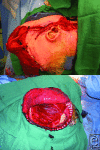Evaluation of options for large scalp defect reconstruction: a 12-year experience
- PMID: 24567771
- PMCID: PMC3931441
Evaluation of options for large scalp defect reconstruction: a 12-year experience
Abstract
Objective: Multiple options for reconstruction of scalp defects exist with local tissue advancement and free tissue transfer the mainstay of reconstruction. Over the last 12 years, our tertiary referral hospital has performed more than 150 scalp reconstructions. We reviewed our experience with large scalp defects and evaluated whether free tissue transfer is a viable first option for reconstruction.
Methods: A retrospective review was conducted of all scalp reconstructions from January 1, 1999, to December 31, 2011. A cohort of patients with defects greater than 50 cm(2) were identified for a total of 64 operations; 10 free flaps, 28 local advancement flaps, and 26 skin grafts. Reoperation rates and complications were compared between groups.
Results: Reoperation rate in the free flap group was 20% (2/10). Both reoperations were within the immediate postoperative period, one for microvascular thrombotic occlusion and the other for postoperative hematoma. The local tissue transfer group had a 14% reoperation rate (4/28), all for debridement of partial flap loss. The skin graft cohort had a 12% reoperation rate (3/26) for 1 complete and 2 partial skin graft failures; all required repeat grafting. Reoperation for free-flap complications did not require rehospitalization. In contrast, the skin graft and non-free flap reoperations frequently required rehospitalization.
Conclusion: Though free tissue transfer has a higher occurrence of reoperation within the immediate postoperative period, completion of reconstruction usually occurs within a single hospitalization. Free tissue transfer is a feasible option, and we advocate for its use as a primary method for repairing large scalp defects.
Keywords: free flap; local tissue flap; microsurgery; scalp defects; scalp reconstruction.
Figures
References
-
- Beasley NJ, Gilbert RW, Gullane PJ, Brown DH, Irish JC, Neligan PC. Scalp and forehead reconstruction using free revascularized tissue transfer. Arch Facial Plast Surg. 2004;6(1):16–20. - PubMed
-
- Hardesty RA, Jones NF, Swartz WM, et al. Microsurgery for macrodefects: microvascular free-tissue transfer for massive defects of the head and neck. Am J Surg. 1987;154(4):399–405. - PubMed
-
- Ioannides C, Fossion E, McGrouther AD. Reconstruction for large defects of the scalp and cranium. J Craniomaxillofac Surg. 1999;27(3):145–52. - PubMed
-
- van Driel AA, Mureau MA, Goldstein DP, et al. Aesthetic and oncologic outcome after microsurgical reconstruction of complex scalp and forehead defects after malignant tumor resection: an algorithm for treatment. Plast Reconstr Surg. 2010;126(2):460–70. - PubMed
-
- Fischer JP, Sieber B, Nelson JA, et al. A 15-year Experience of complex scalp reconstruction using free tissue transfer-analysis of risk factors for complications. J Reconstr Microsurg. 2013;29(2):89–98. - PubMed
LinkOut - more resources
Full Text Sources



